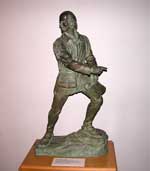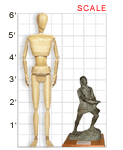VAM galleries including this work:
The Filson Historical Society | Kentucky Past and Present || VAM Home
Felix de Weldon (Austrian, 1907-2003)
GEORGE ROGERS CLARK, c. 1973
Bronze; 38" tall
The Filson Historical Society
George Rogers Clark (1752-1818) was an American Revolutionary War general, a frontiersman, and the founder of Louisville. He is called “The Conquerer of the Northwest” for his aggressive campaigns against British-held posts north of the Ohio River at the settlements of Kaskasia, Cahokia, and Vincennes. A base camp at the Falls of the Ohio near Louisville was the staging ground for these campaigns. Clark lived the last years of his life in Louisville at Locust Grove.
This sculpture is a study for a heroic-sized statue of Clark designed by one of America’s foremost bronze sculptors of the 20th century. The full-sized statue is located on Louisville’s Belvedere overlooking the Ohio River, with Clark’s figure pointing west to victory and glory.
About the Artist
Sometimes referred to as the “Michelangelo of the 20th century,” Felix W. de Weldon created more than 1,200 public monuments honoring a wide range of military heroes, statesmen, and religious leaders as well as notable events. They include a statue of Admiral Byrd located in Antarctica, which makes de Weldon the only artist in the world to have works on all seven continents. He is perhaps best known for the famous sculpture showing Marines raising the American flag on Iwo Jima.
De Weldon was born in Vienna, Austria, on April 12, 1907, the son of a wealthy textile manufacturer. Like most Viennese families before World War I, the de Weldons shared a love of music. In and around Vienna were the homes of Beethoven, Mozart, Strauss, Schubert, and Brahms. But Felix was precocious in a different art form. He entered the St. Egidius School and had his first formal lesson in art at age 6. His teachers recognized his talent immediately and were soon taking him to museums to copy old masters. After his 10th birthday, de Weldon entered Marchetti College, a preparatory school where he studied art, history, languages, anatomy, and engineering. At age 17, he won his first national sculpture contest in Austria and began exhibiting his work at the Paris Salon in Vienna, quickly achieving international recognition.
After graduating from Marchetti with a Bachelor of Arts degree in 1925, de Weldon entered the University of Vienna’s Academy of Creative Arts and School of Architecture. He received Master of Arts and Master of Science degrees in 1927 and a Doctor of Philosophy degree in 1929, at the age of 22.
De Weldon then set out for two years of travel to broaden his knowledge of the ancient and modern arts. Visiting Italy, Spain, Portugal, France, Greece, Egypt, Palestine, and Syria, he studied such masters as Michelangelo, Raphael, Leonardo, and Goya. Between 1933 to 1937 he established a residence and studio in London.
In 1935, de Weldon was commissioned to create a bust of King George V to commemorate the 25th year of his reign. The bronze was originally displayed in Buckingham Palace, then was moved to the National Portrait Gallery in London, where it still stands. No other artist ever had his or her work displayed there while still alive.
De Weldon continued to create additional sculpture commissions for royal families around the world. While traveling to Canada to sculpt a bust of the late Prime Minister Mackenzie-King, he stopped in New York City and was immediately captivated by life in the United States. He moved from London to America in 1938 and became a U.S. citizen in 1945. During World War II, he joined the Navy and served as the official artist for naval aviation. He also was commissioned by the federal government to create several special sculptures, including his best-known work, the 48'-high monument commemorating the flag raising on Iwo Jima. The monument took nine and one-half years to complete and was dedicated as the Marine Corps War Memorial in Arlington, Virginia, on November 10, 1954.
In 1950, President Harry Truman appointed de Weldon chairman of the United States Fine Arts Commission; he was re-appointed in 1956 by President Dwight Eisenhower. In 1961, President John F. Kennedy named him to the Presidential Fine Arts Council. He became Sir Felix de Weldon in 1959, when he was knighted for his service to the British Crown.
De Weldon died in 2003 at the age of 96.
Classroom Ideas
Discussion: Who was George Rogers Clark? What part did he play in Kentucky’s history? What does this statue convey about him? What qualities does it suggest?
Compare this and other works by de Weldon to works by Kentucky sculptor Ed Hamilton (including Cinque in the Speed Art Museum gallery and The Spirit of Freedom in the Kentucky Historical Society gallery). What do the works have in common? How do they differ? Research de Weldon’s other works, including Flag Raising on Iwo Jima. Does that work also have a Kentucky connection?
Activities: Research de Weldon’s works and create a world map showing works on each continent.
Choose a person or event that is heroic to you and design a monument honoring that person or event.
Links
The Felix de Weldon International Art Gallery includes information about De Weldon and lists and images of his works.
[www.felixdeweldon.com]
Learn more about De Weldon and his work at the SPQR
Fine Art web site.
[www.spqrfineart.com/Amtribute.html]
Read a biography of George Rogers Clark at the Indiana Historical Bureau web site.
[www.statelib.lib.in.us/www/ihb/resources/grcbio.html]

